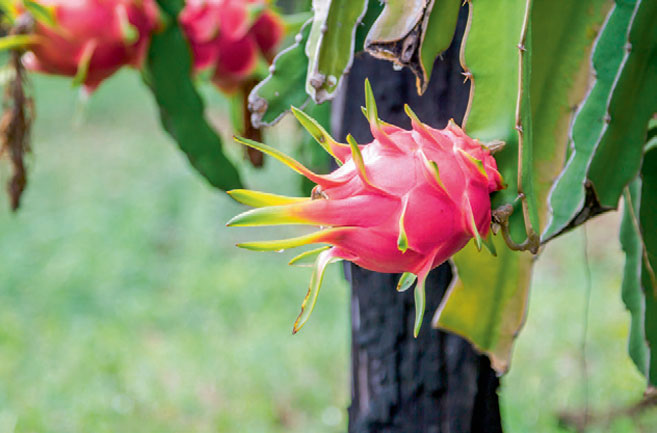Growing Your Own Dragonfruit
Got sun and a sturdy trellis? Plant this vining cactus and you may be rewarded with colorful, refreshing fruits.
I just love the color of dragonfruit in fruit salads! Is this something I can grow in my backyard?
You’re probably referring to the types of dragonfruit that are red, magenta or pink on the inside. There are also delicious varieties that are white on the inside, but these might not be the look you are going for in fruit salad.
Dragonfruit, aka pitaya, is a vining cactus. It originated in tropical Central and South America and has now spread throughout many tropical parts of the world and is quickly gaining popularity. For instance, it’s the most important export fruit of Vietnam.
As long as you have lots of sun and a strong trellis for them to grow on, this is definitely something you can plant in your backyard. Usually, the trellis consists of a wooden post that has a square or circular support on top. The vine is trained to grow vertically along the post, and then branch out sideways as it reaches the top support. They can also be grown on an arbor-type trellis, on a small tree or rock wall.
If installing a post, I recommend getting one that is 7-8’ long and digging a hole 18-24” deep. For extra strength and durability, add 1-2 bags of concrete in the hole. A fully grown plant can weigh over 300 pounds, so make your trellis robust.
The flowers of the plant don’t self-pollinate in certain species and cultivars, so plant two or three plants or cuttings with different genetics to assure better fruiting. This means that they cannot be two or three clones from the same plant.
Dragonfruit prefer lots of sun, rich well-draining soil, regular fertilization and regular watering during flowering and fruiting (summer and fall). Given proper conditions, dragonfruit plants can live up to 20 years and produce over 200 pounds of fruit a year. They provide a contrasting aesthetic to the edible landscape and the fruit is wonderfully light and refreshing in the heat of summer.
Now that my winter garden is finished, I was thinking about planting sweet potatoes. Do they grow well here?
Sweet potatoes are definitely a good option for late spring and summer planting for edible gardeners in South Florida. However, if you’re referring to planting them in your raised garden box, I don’t recommend it. Sweet potatoes don’t really form potatoes well if the soil is overly rich and not well-draining, which is the case in many raised beds, particularly in the rainy season. When they’re planted in rich mucky soil, the roots often will grow downwards and the potatoes will form in the sandy native soil below the rich soil in the raised beds. When this happens, the potatoes are very difficult to find and harvest, and they’re hard to remove in the fall when it’s time to plant for cool weather. If you don’t remove them completely, they’ll continue to grow and they’re weedy.
Sweet potatoes take about three to four months from planting to harvesting if planted in full sun, but take six or more months if planted in part sun. Take this into account if you decide to plant sweet potatoes as a summer crop. Also keep in mind that sweet potatoes are vines that grow somewhat aggressively and will cover an area much larger than the area in which they were initially planted. For these reasons, we prefer to grow them in an area separate from the main veggie and herb garden, where the soil is sandy and of low to medium fertility.
Sweet potatoes are usually planted as cuttings or slips (baby plants sprouted from mature potatoes) in rows spaced 4-5’ apart and then planted with about 1 foot in between each plant. In the beginning, water regularly to help the new plants to become established, as well as throughout the season, as long as the soil is well draining and not overly moist or mucky. Pests can be an issue, they’re less apparent if the sweet potatoes are rotated with other crops and not planted over and over in the same spot.
After at least three months (longer if there is shade), you can start carefully digging in the soil around the thickest stems, where the plants were initially planted. If the potatoes seem too small, leave them in the ground to grow larger. However, if they’re big enough, go ahead and harvest them. Some people like to add soil on top of them, or sink into the soil sections of the stem to increase production.
Once harvested, make the potatoes sweeter by storing them in a dark warm room or covered outdoor area for two weeks or more. Sweet potatoes are definitely worth growing if you have enough space. They’re probably my favorite root crop for growing in South Florida’s summer.
Have an edible gardening question? Email Dylan at garden (AT) ediblesouthflorida (DOT) com.






